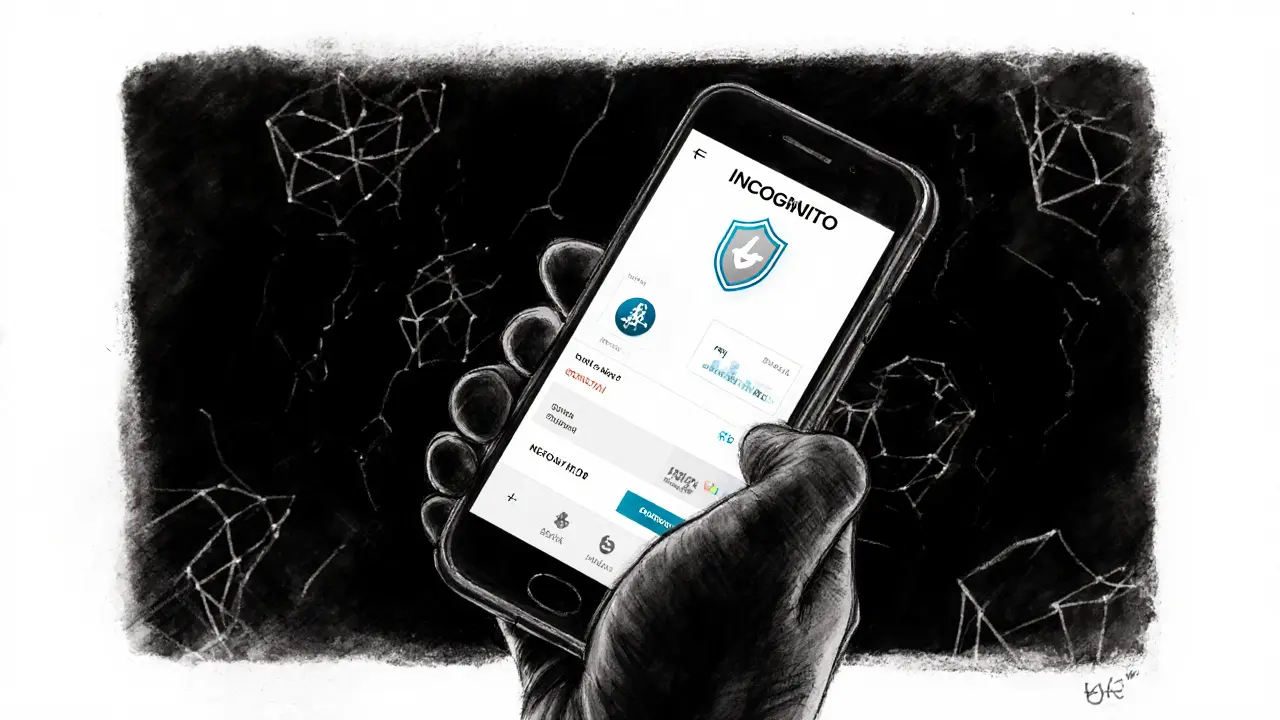Incognito pDEX Feature Comparison Tool
Compare DEX Features
See how Incognito pDEX stacks up against popular decentralized exchanges in terms of privacy, fees, liquidity, and accessibility.
| Feature | Incognito pDEX | Uniswap | PancakeSwap |
|---|---|---|---|
| Privacy | Full transaction obfuscation | Public on Ethereum | Public on BSC |
| Fees | 0% (network fee only) | 0.30% per trade | 0.20% per trade |
| Liquidity Depth | Low - shallow pools | High - billions daily | High - billions daily |
| Access Platform | Mobile app only | Web & mobile | Web & mobile |
| Open Source | Yes (GitHub) | Yes | Yes |
| KYC Requirement | None | None | None |
Key Insights
- Privacy Focus: Incognito pDEX provides complete transaction obfuscation using zero-knowledge proofs, unlike public blockchains.
- Zero Fees: No protocol or spread fees, making it ideal for frequent traders seeking low-cost swaps.
- Limited Liquidity: Shallow pools result in higher slippage for large orders compared to major DEXs.
- Mobile-Only: Accessible only via mobile app, limiting desktop capabilities.
- Open Source: Fully auditable codebase on GitHub enhances trust among security-conscious users.
TL;DR
- Incognito pDEX is a privacy‑first, non‑custodial DEX that runs on the Incognito blockchain.
- Zero trading fees make it cheap, but low liquidity can cause slippage.
- Only accessible through the mobile app - no web UI, no account registration.
- Open‑source code, but limited community support and scarce market data.
- Best for traders who value anonymity over deep liquidity and advanced charting.
When it comes to trading crypto without leaving a trace, Incognito pDEX is a privacy‑first decentralized exchange built on the Incognito blockchain that lets users swap assets without registration or fees. Launched in November 2019 by a Vietnam‑based team, the platform markets itself as the go‑to place for completely anonymous crypto swaps. In this review we’ll break down how it works, what you get out of the experience, and whether the trade‑off between privacy and liquidity makes sense for you.
What Is Incognito pDEX?
Incognito pDEX (short for privacy Decentralized Exchange) lives on the Incognito blockchain a layer‑2 network that hides transaction details using zero‑knowledge proofs. Unlike typical DEXs that broadcast every swap on a public ledger, pDEX routes trades inside an encrypted environment, so no one can see which tokens you moved or how much you spent.
How Does the Privacy Mechanism Work?
The core idea is simple: when you initiate a swap in the app, your assets are first moved into a private “shielded” pool on the Incognito chain. From there, the exchange matches you with a counter‑party inside the same pool, executes the trade, and then releases the newly acquired tokens back to your wallet-all without ever publishing the trade details. The technology relies on zero‑knowledge proofs, which let the network verify that the swap is valid without revealing the underlying numbers.
Access & User Experience
All trading happens inside the official Incognito mobile app available for iOS and Android, offering a one‑stop wallet, privacy tools, and the pDEX interface. There’s no web portal, no email sign‑up, and no KYC forms - just download, create a hidden wallet, and you’re ready to trade.
The app’s UI is clean: a “Swap” tab, a list of supported pairs, and a togglable privacy mode. Because the platform is mobile‑only, you miss out on desktop‑grade charting tools, but the simplicity works for users who want a quick, on‑the‑go swap.
Zero‑Fee Structure
One of the headline features is a true zero‑fee policy. Incognito pDEX does not charge a protocol fee, nor does it levy a maker/taker spread. The only cost you might see is the underlying network fee on the Incognito blockchain, which is typically a fraction of a cent. This makes the exchange ultra‑cheap for high‑frequency traders who hate paying 0.2‑0.3% on every trade.
Liquidity & Market Data
Here’s where the trade‑off appears. Because the exchange is private, liquidity providers are reluctant to lock large amounts of capital in a pool that offers no visibility. As a result, most pairs have shallow depth, and you’ll often notice higher slippage on bigger orders.
CoinMarketCap lists pDEX as an “Untracked Listing” - there’s no public volume, market‑cap, or price data. The app itself shows only the pairs it currently supports, and those can change without notice. Compared with giants like Uniswap a leading Ethereum‑based DEX with billions in daily volume or PancakeSwap the top BSC DEX, also processing massive daily trades, pDEX’s market presence is modest.

Security & Open‑Source Philosophy
The codebase is fully open‑source on GitHub, allowing anyone to audit the smart contracts and the privacy layer. This transparency is a plus for security‑savvy users, but the limited documentation can be a hurdle for newcomers.
Since the platform is non‑custodial, you keep full control of your private keys. There’s no “exchange wallet” that could be hacked, and the zero‑knowledge proofs add an extra cryptographic shield. However, the trade‑off is that you won’t get the same level of customer support you might expect from a custodial exchange.
Regulatory Landscape
Privacy‑centric services sit in a gray zone worldwide. Many jurisdictions are tightening AML/KYC rules, and exchanges that hide transaction data can attract regulatory scrutiny. Because pDEX requires no user data, it sidesteps direct compliance but also makes it harder for the platform to engage with regulators or to obtain listings on mainstream data aggregators.
Pros & Cons
- Pros
- Complete anonymity - no KYC, no public trade history.
- Zero trading fees keep costs ultra‑low.
- Open‑source code allows independent audits.
- Mobile‑first design is handy for on‑the‑go swaps.
- Cons
- Limited liquidity leads to higher slippage.
- No web interface - desktop traders may feel constrained.
- Untracked market data makes price discovery harder.
- Sparse community support and documentation.
- Potential regulatory risk as privacy laws evolve.
How Incognito pDEX Stacks Up Against Other DEXs
| Feature | Incognito pDEX | Uniswap | PancakeSwap |
|---|---|---|---|
| Privacy | Full transaction obfuscation | Public on Ethereum | Public on BSC |
| Fees | 0% (network fee only) | 0.30% per trade | 0.20% per trade |
| Liquidity depth | Low - shallow pools | High - billions daily | High - billions daily |
| Access platform | Mobile app only | Web & mobile | Web & mobile |
| Open‑source | Yes (GitHub) | Yes | Yes |
| KYC requirement | None | None | None |
Future Outlook
The privacy‑DEX niche is still emerging. As governments tighten rules on anonymous crypto activity, platforms like Incognito pDEX may face pressure to add compliance layers or risk being blocked in certain regions. On the flip side, demand for private trading tools is unlikely to disappear - traders who need to move funds discreetly will keep searching for solutions.
If the Incognito team can attract more liquidity providers, perhaps by offering incentives or integrating with privacy‑focused stablecoins, the exchange could narrow the gap with mainstream DEXs. Until then, the platform remains a specialized tool for a specific audience rather than a universal swap solution.
Bottom Line
If you value anonymity above everything else and don’t mind navigating a mobile‑only, low‑liquidity environment, Incognito pDEX delivers on its promise of private, fee‑free trading. For the average trader who needs deep liquidity, price charts, and community support, a more established DEX like Uniswap or PancakeSwap will likely feel more comfortable.

Frequently Asked Questions
Is Incognito pDEX truly free to use?
Yes, the platform does not charge a protocol fee or a maker/taker spread. The only cost you’ll see is the tiny network fee on the Incognito blockchain, which is usually a fraction of a cent.
Can I trade on a desktop computer?
No. pDEX is only accessible through the official Incognito mobile app for iOS and Android. There is currently no web portal or desktop client.
How does pDEX keep my trades private?
When you initiate a swap, your tokens are moved into a shielded pool on the Incognito blockchain. The trade is matched inside that pool using zero‑knowledge proofs, so no external observer can see which assets were exchanged or in what amount.
Why is there so little liquidity on pDEX?
Privacy features make it harder for market makers to see order books or provide arbitrage opportunities. Many liquidity providers prefer transparent platforms where they can gauge depth and price impact, so pDEX pools tend to be smaller.
Is the code really open source?
Yes. The entire pDEX codebase is published on GitHub, allowing anyone to review, audit, or fork the project. However, documentation is sparse, so a bit of technical know‑how helps.


Wow, the privacy angle on Incognito pDEX is really something – it feels like stepping into a secret club where nobody can see what you’re swapping. The zero‑fee allure is also a big magnet for folks who trade a lot, but be ready for those slippage bites when you move sizable chunks. It’s a classic trade‑off: anonymity versus depth.
Honestly, who needs any of that public ledger nonsense? If you’re okay with a mobile‑only app, this is the perfect stealth playground. The only gripe is the lack of desktop tools – you’re stuck on your phone, which can get messy when you’re trying to read charts.
While the concept is intriguing, the execution leaves much to be desired. Low liquidity translates directly into higher price impact, and the absence of any robust data feeds makes it hard to gauge real market conditions. Moreover, the platform’s reliance on a single mobile client introduces a single point of failure; if the app crashes or the server goes down, you’re essentially locked out. The zero‑fee claim is nice, yet the network fees, however minuscule, still exist, and they can add up under heavy usage. Lastly, the privacy guarantees hinge on the correct implementation of zero‑knowledge proofs, which, if flawed, could expose user data anyway.
That privacy‑first approach is impressive, but the shallow pools feel like trying to fill a bucket with a leaky tap. If you’re a regular trader, the slippage will bite you hard, especially on less popular pairs.
Zero fees? Sign me up! Just keep in mind that you’ll still pay the underlying blockchain fee – it’s tiny, but it’s there. The mobile‑only thing is a double‑edged sword: super convenient for on‑the‑go swaps, yet limiting for those who love fiddling with charts on a big screen.
Totally agree – the fee‑free vibe is refreshing, especially for high‑frequency moves. The only thing that bugs me is the limited pool depth; you’ll see bigger price swings on larger trades, which can be a real pain.
Privacy is the new gold, and this platform nails it. The fact that there’s no KYC is a huge plus for anyone who values anonymity. Just watch out for the liquidity dip – it’s a small price to pay for privacy.
The mobile‑only design is a gamble – it works for quick swaps, but it feels limiting when you need detailed analytics. Still, for a stealthy trader, it's a solid option.
Incognito pDEX is a fascinating experiment at the intersection of privacy and decentralized finance, and it certainly lives up to its promises in several key areas. First and foremost, the zero‑fee model is a breath of fresh air in a landscape where most DEXs levy a 0.2‑0.3% spread on each trade; this can dramatically reduce costs for high‑frequency traders or those moving small amounts. The privacy mechanism, built on zero‑knowledge proofs, effectively hides transaction details, providing a level of anonymity that is rarely seen outside of privacy‑centric coins like Monero. This obfuscation can be crucial for users operating in jurisdictions with strict capital controls or for anyone simply wishing to keep their financial activities private. However, the trade‑off comes in the form of liquidity. Because the platform is relatively niche and privacy‑focused, liquidity providers are hesitant to commit large sums, resulting in shallow pools and increased slippage for larger orders. This is evident when comparing the depth to giants like Uniswap, where billions of dollars flow daily. Additionally, the mobile‑only access model, while convenient for on‑the‑go swaps, excludes desktop users who rely on advanced charting tools and larger screen real‑estate for analysis. The lack of a web UI also means that community‑driven tools and plugins are virtually nonexistent. From a security standpoint, the open‑source nature of the codebase is commendable, allowing independent audits and fostering trust among technically‑savvy users. Yet the sparse documentation can be a barrier for newcomers who might struggle to set up a shielded wallet correctly. Finally, regulatory considerations cannot be ignored; operating in a gray area without KYC may attract scrutiny from authorities, potentially leading to future compliance demands that could alter the user experience. In sum, Incognito pDEX shines as a privacy‑first, fee‑free DEX, ideal for users who prioritize anonymity and cost efficiency over deep liquidity and advanced analytics.
Great pick on the privacy front, but the low pool depth will bite you if you try big trades. Still, for small swaps it’s pretty neat.
Great insight!
Indeed, the fee‑free environment is attractive, yet anyone thinking about larger positions should definitely keep an eye on the slippage numbers – they can get nasty fast.
The open‑source aspect is a major win for the crypto community, allowing independent verification of the privacy proofs. Nonetheless, the scarcity of thorough documentation can be a roadblock for newcomers.
While the code is out there for anyone to audit, the real test is whether the zero‑knowledge implementation is flawless – even a tiny flaw could compromise the whole privacy premise.
Zero fees sound awesome, but low liquidity is a real deal‑breaker for anyone looking to move more than pocket change.
Honestly, the whole “privacy‑first” hype feels a bit overblown when you can’t actually get decent depth; it’s like bragging about a fancy car with no engine.
From an analytical standpoint, the platform’s lack of public market data hampers any meaningful price discovery, rendering it unsuitable for strategic traders.
True, without visible order books you’re basically flying blind, which can be risky if you’re not comfortable with the inherent uncertainty.
Nice rundown! 👍
Freedom from KYC is great, but let’s not forget that regulators are catching up fast – anonymity may become a liability sooner rather than later.
The technical architecture, leveraging zero‑knowledge proofs on a layer‑2, is elegant and showcases the potential of privacy‑preserving DeFi. However, the ecosystem’s maturity is still nascent, and broader adoption will hinge on solving liquidity constraints and achieving regulatory clarity.
Solid analysis overall. If you prioritize privacy above all, pDEX is worth a try, but keep an eye on the evolving regulatory environment and liquidity incentives.